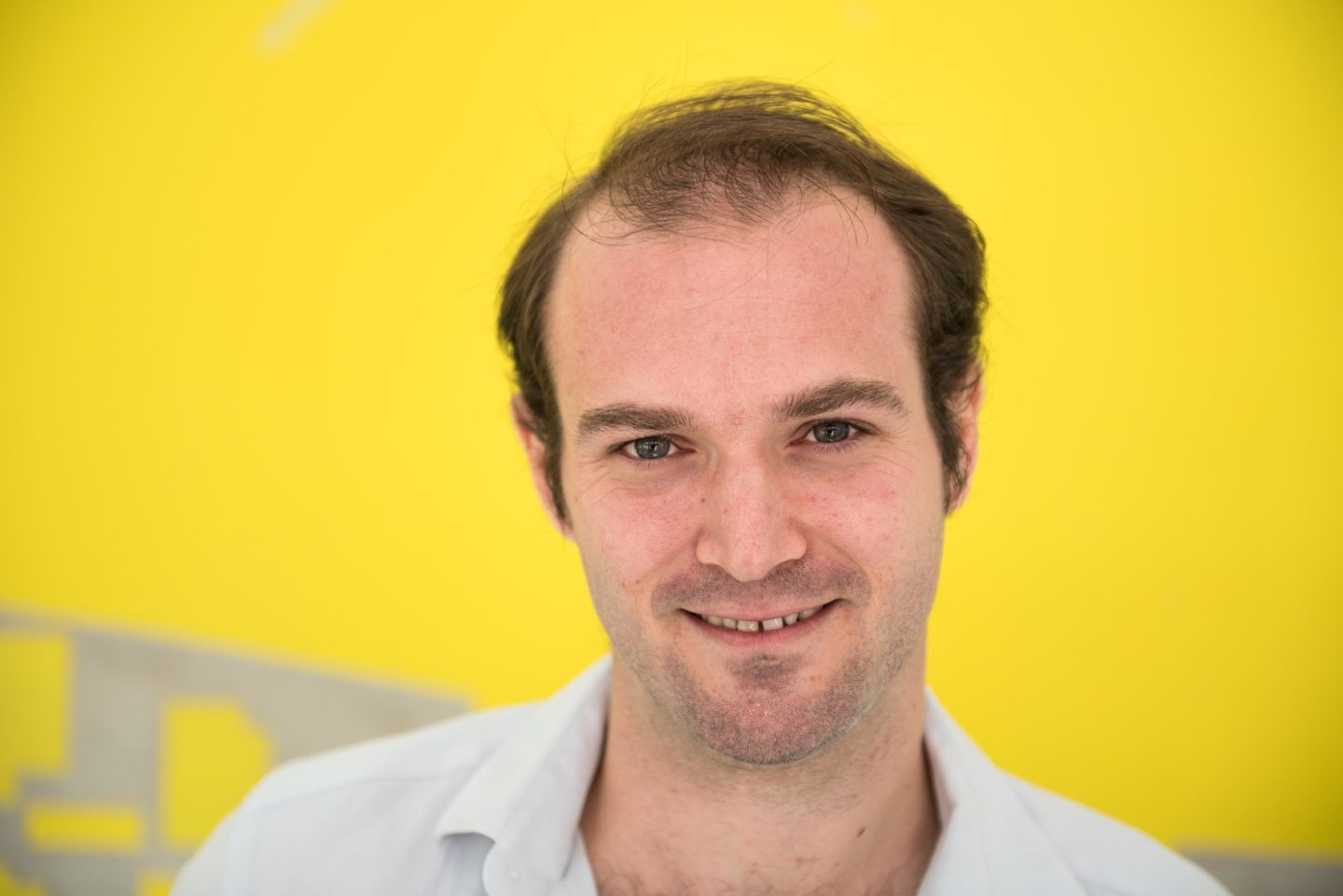
MAX PLANCK INSTITUTE FOR INTELLIGENT SYSTEMS, TÜBINGEN, GERMANY
Michal Rolinek was a PhD student at IST Austria. He now works as a postdoc at the Max Plank Institute for Intelligent Systems. At IST Austria Michal Rolinek was in the Kolmogorv Group.
He returned to campus as a speaker at the Science Industry Day 2018 and found the time to give an interview and answer some interesting questions about his work.
Watch the corresponding video on YouTube
I don’t have a business card but if I had one it would say that I am a postdoc at the Max Plank Institute for intelligent systems.
In our group, we are trying to connect new methods for artificial intelligence and to connect it with the world of robotics. And the coolest thing is that we have a whole floor of robots.
I don’t have a particular plan right now. Luckily we live in the days where there are amazing opportunities for computer scientists so I will just wait and see where they take me.
I got my master’s degree in Prague in mathematical analysis and here at IST, I got my PhD in theoretical computer science.
IST played a massive role for my career. I am really happy to say that the opportunities that I have right now are nothing I was imagining three or five years ago and if you told me I would not have believed it.
One, learn as much as you can about as much as you can. I think that IST is a great place for learning no matter which position you are holding here.
Two, be compassionate the academic environment can be very pressurizing and stressful and the sources of stress can be often different for different people so it is hard to relate. Care for the wellbeing of your coworkers and they will do the same for you.
Three, do it for the joy. I think that joy is the best motivation to do science or to do anything really.
I have had so many great memories. I had a great time in our office and playing football great time at retreats. But if I were to pick one it was the few boxing matches I had in the lecture hall.
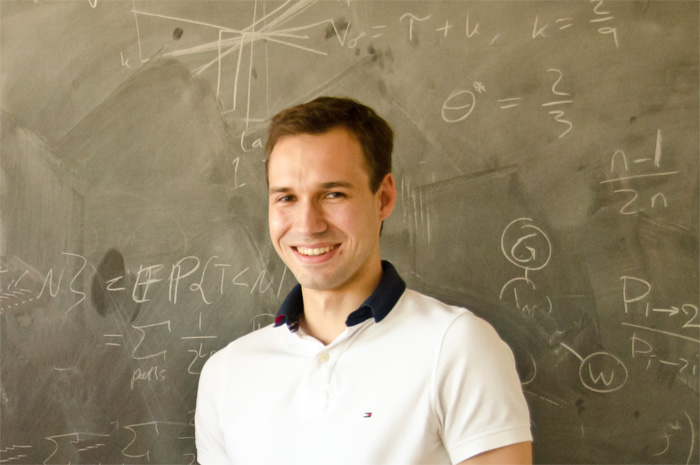
MY RESEARCH LIES AT THE INTERFACE OF COMPUTER AND BIOMEDICAL SCIENCES AND FOCUSES ON THE STOCHASTIC PROCESSES UNDERLYING EVOLUTION. I DEVELOP COMPUTATIONAL METHODS TO LEARN FROM LARGE-SCALE BIOLOGICAL DATA SETS AND BUILD MATHEMATICAL MODELS TO EXPLAIN OBSERVATIONS ON A MECHANISTIC FASHION.
MOST RECENTLY, I FOCUSED ON INFERRING THE EVOLUTION AND THE SEEDING OF METASTASES IN PANCREATIC CANCERS.
Johannes Reiter returned to campus in Fall 2018 to give a special Think and Drink and to share his research with the current campus community. He also found time to do a video interview with us.
Watch the corresponding video on YouTube
I don’t really have a business card but if I had one it would say Johannes Reiter instructor at the Canary Center for Cancer Early Detection at Stanford University School of Medicine.
The coolest thing is that I can work on a globally really important disease. I work on tumors and specifically tumor evolution. I try to approach this problem from a mathematical perspective I try to come up with a quantitative framework that can describe the evolution of cancer.
In the future, I still want to be at the interface of multiple fields like computer science, biology and medicine. I also want to do research in academia perhaps also together at a medical school or a hospital and work together with various researchers from these various disciplines.
My background is in computer science, originally I actually did computer engineering. Then I did computer science at the Technical University in Vienna. When I came to IST I wanted to stay in computer science but I kind of got into theoretical biology and towards the end, I got more into cancer evolution and combining data analysis and mathematical modeling.
IST played a really important role in my career because before I started here I saw myself as an engineer and not as much as a scientist. But then when I started my PhD here I got introduced into so many different areas and I got interested in areas outside of computer science and outside of computer engineering. And that is also the most interesting thing about my job currently. That I can work with experts from various different fields and that keeps my job interesting.
My advice would be: think critically and deeply, try to become independent and ask your own questions, very early on in your career. And perhaps do an internship in industry so you have a good comparison between research that is happening in academia and research that is happening outside of academia.
My favorite memory of IST are definitely all the table soccer games which we played for a lot of time basically every day after lunch.
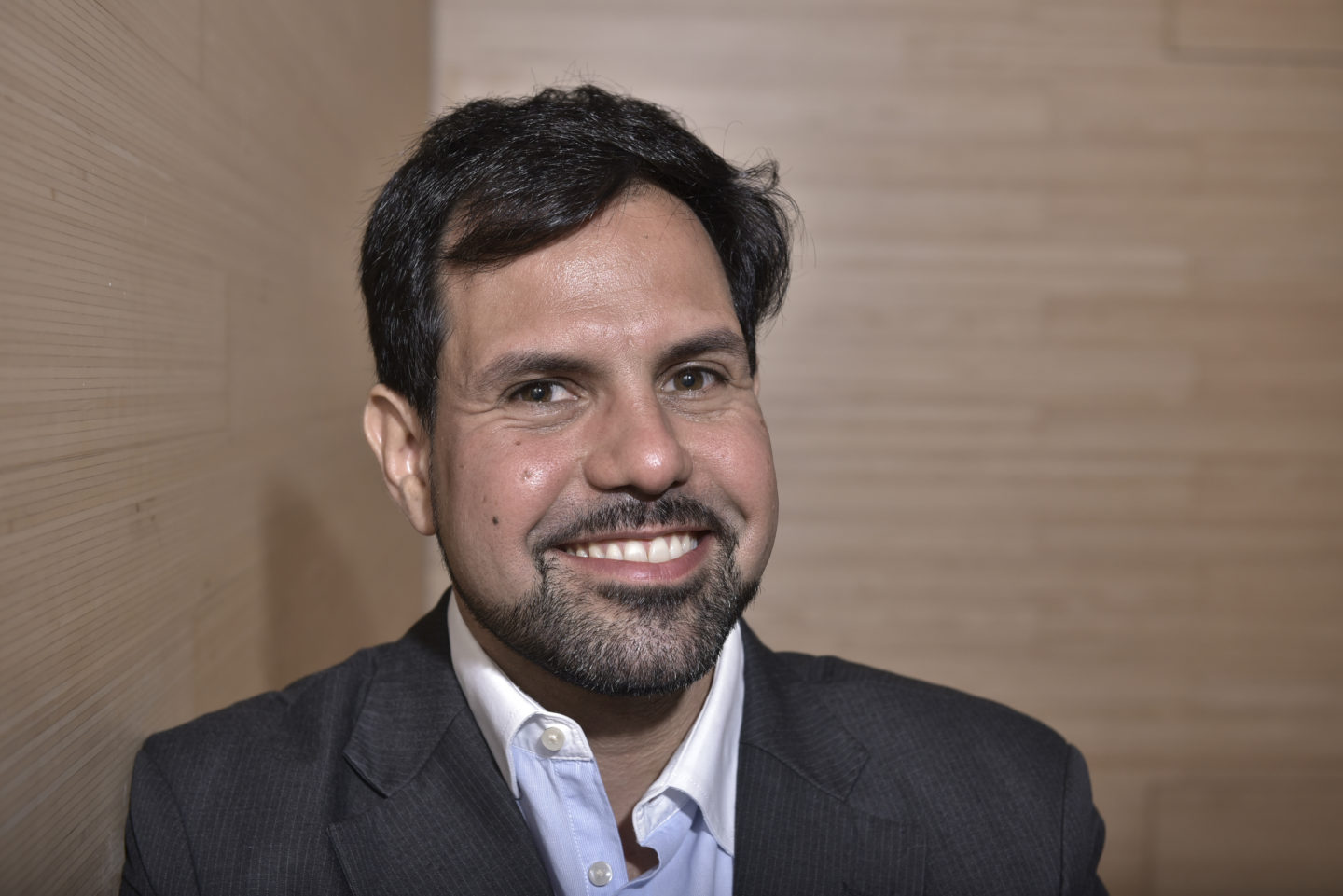
Harold de Vladar was at ISTA from 2009 to 2013 as a postdoc in the Barton Group. He is now CEO and founder of Ribbon Biolabs GmbH. In an interview with Daniela Klammer and Kathrin Pauser which took place during the Science and Industry Day 2017 he talks about what he likes about his research but also about his career and about his time at ISTA when the institute was still very small.
Harold de Vladar, my position: CEO and the name of my startup which is Ribbon Biolabs GmbH.
The essence of my job is to develop the technology to secure the IP of the technology and also to consolidate and make sure that the team is on a good track to develop the technology.
The limitations is that once you start with your own startup you have less freedom to do other things and when you come from an academic background you are probably excited about so many things and then you find yourself restricted doing stuff that you didn’t want to do in the first place like financial sheets or business plans. Which you have to do but what you want to do is just do experiments and equations’ stuff. The cool thing is that you are working for something that is entirely yours. It’s not like working for an institute for two years and after the two years that’s it. It is money you get and you construct your own stuff so it is yours. You develop it as you want you do exactly what you want it is your decision what you are doing and that rocks.
I want to develop this company obviously and I want to be in a position where I am developing new ideas new products or solving new problems related to science. So tech transfer if you wish but real problems and I want to do things that are a bit non canonical, not the standard things. I know it sounds a bit abstract but biology is very vast. There are many interesting things there that you can actually take and make a product out of it for a specific purpose. This is the things I like to make. I would also like to keep a bit of research going like basic research or more explorative research in order to allow the serendipity factor to come to new possibilities.
It’s a complex one. I started as a cell biologist and statistical physics at the same time. Then went into applied math’s only to get more formal tools to work with my stuff related to genetics and evolution. Then I did my PhD in evolutionary ecology, actually I did my PhD in evolution in a group of evolutionary ecology which is what let me to Nick Barton and that is how I ended up at ISTA. And I also have a degree in art and science which sounds very disconnected to all this but it is not.
First of all the connectivity how I connected to the people here which are now in different places either because they were postdocs or because they were exprofessors from here in some other places this allowed a lot of connections directly or indirectly. That was something very important.
And what was also crucial. Having worked with someone like Nick Barton this was an amazing endorsement. We did great job Nick and I, what we did was awesome. It was not on the side of being extra productive but more on the side of taking very challenging problems and solving them. So it was not like salami slicing papers and that created a very idiosyncratic way of seeing science for me because I always gave more importance to this aspect than to publish many papers something that many universities don’t like.
So ISTA determined my career in these two ways in the way I see it but also which options do I have but not by restricting them but by me realizing what is it what I want to do. I always felt more comfortable in Institutes of advanced studies small places where you can think of new things rather than the big shot universities where people go mad with the latest nature cover and you have to race with them. That’s not my style.
For the postdocs of ISTA: Things have probably changed a lot since I left ISTA but I think there are two levels of things that you have to learn as a postdoc. First of all you have to do your work project as it means of learning maturing etc. but you also have to keep a close eye on what you want and what are the next career steps. You can get very distracted with your project and forget that there is a future that you have to fulfill. And I saw many postdocs forgetting these things.
Second, I feel like there is a lot of gab between what is a postdoc and what is a professor and ISTA doesn’t give this feeling of continuity between one and the other. I think at least in my time it was great to be here as a first postdoc but not as a second because you won’t have that much independence you won’t have that much support beyond your project.
I think it was one of these barbeques and we went into the pond, swimming in the pond. I don’t think Tom Henzinger was so happy with us the next day. This was when ISTA was relatively small. We could have staff meetings of the whole institute every week and these meetings didn’t get to more than 20 people. None of the building existed. That was very fun.
Very simple what kind of problems do I really want to solve and how.

Stefan Huber was at IST Austria from 2013 to 2015 as a postdoc in the Edelsbrunner Group. He is now a researcher at Bernecker + Rainer in industrial R&D. In his interview, he talks about his research but also about his career and about his time at IST Austria.
Stefan Huber, Research and Development
I designed the software concept that means the algorithms, the mathematical models for the next generation industrial transport system of B&R which is called ACOBOStrak.
The coolest thing I think is: It is a very interdisciplinary project. There are bright people from control theory, from mathematics, computer science and together we shape a new kind of technology that could actually change the way industrial machines are built in the future.
I believe that the current R&D project I am working on kind of demonstrates how computer science has a deep impact on industrial automatization. I think this is only a start so in the future I would like to shape a stronger group in the company that focuses on computer science algorithms and mathematics.
My academic background is actually algorithms more precisely it is computational geometry and topology so I have a double degree in computer science and mathematics. I studied in Salzburg I did my PhD in computational geometry and then for a short time I was a senior scientist at the math department. After that I joined Herbert Edelsbrunner’s group at IST Austria for two years in computational topology.
To me IST Austria was intellectually very inspiring. So looking back at IST I see that the experiences that I gained at IST gave me a lot of confidence and trust in scientific principles and that again has an influence in my work because I know that I can trust on scientific methodologies to solve the problems I face in my industry job.
First actively participate in intellectual exchanges.
Try to go to as many workshops and conferences as you can do.
And third use the freedom and opportunities you get from IST Austria. In my case I wasn’t forced to pursue a particular direction in my research. So that’s a nice thing you are completely open. They are very generous when it comes to visiting conferences and there are a lot of scientific visitors to get in touch and to have discussions after a talk when drinking a glass of wine or going to Heurigen.
What I really loved was when there were big visitors like Steve Smale and we went to Heurigen for dinner in the evening and the kind of talks that developed at an evening event are quite different and I enjoyed that very much.
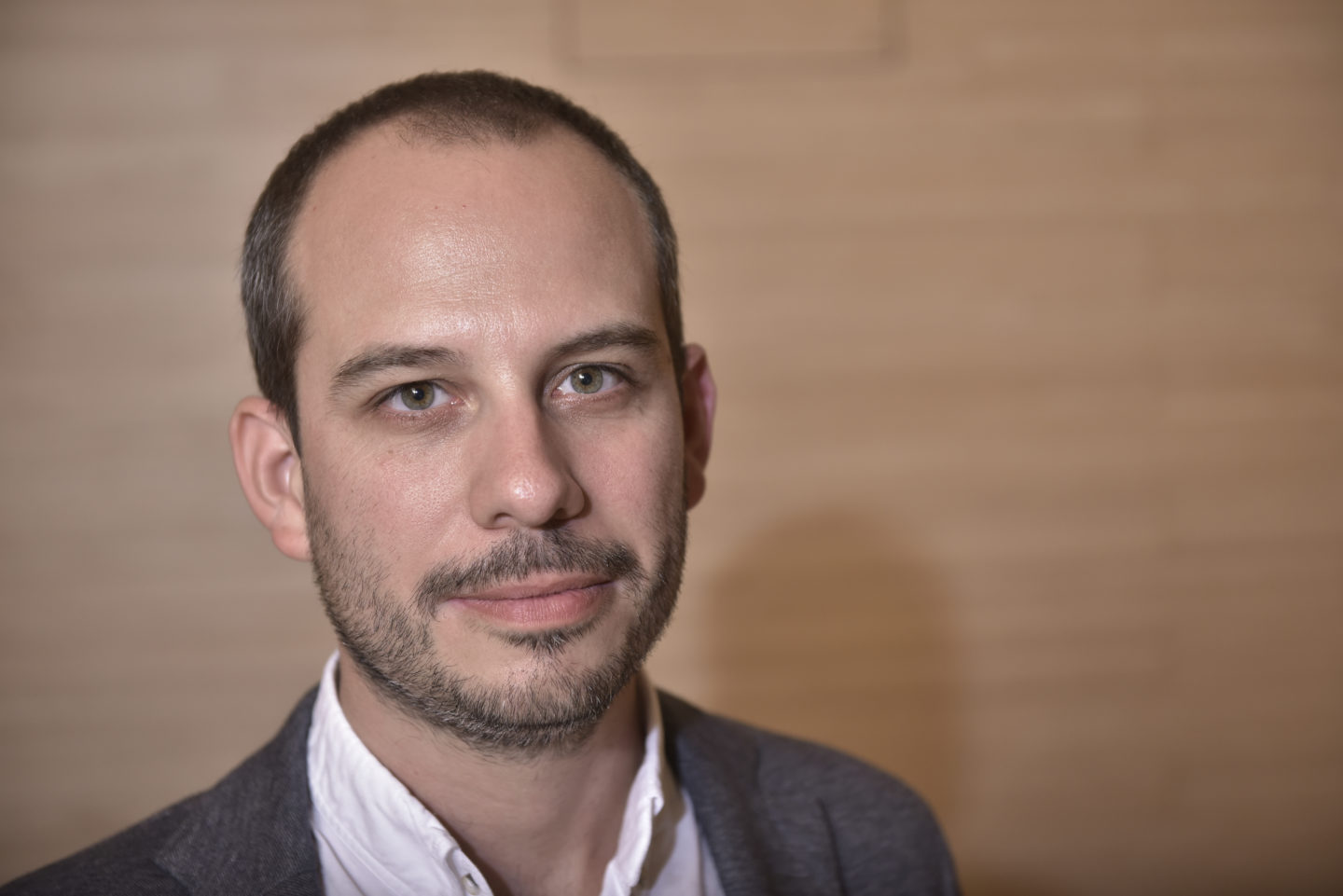
Vicent Botella-Soler was a Postdoc at IST Austria. He now works for ForwardKeys in Spain. ForwardKeys analyses global travel movements to help companies improve their tactical decision making. At IST Austria Vicent Botella-Soler was a Postdoc in Gašper Tkačik’s group.
In an interview with Daniela Klammer and Kathrin Pauser which took place during the Science and Industry Day 2017 he answered some interesting questions about his work.
Vicent Botella-Soler, Innovation and Machine Learning Manager at ForwardKeys
At ForwardKeys we analyze large datasets from the travel industry to provide forecasts and insights to our clients. We maintain a daily-updated database of all the flight bookings worldwide. The analysis of this large amount of data allows us to answer interesting questions in industry sectors such as retail, hospitality, tourism management or financial services.
It is very nice to have a sort of magnifying glass above the planet and watch, almost in real-time, how people move around and how different events and contexts affect the flow.
Limitations are all the typical limitations intrinsic to working with data…there are plenty of them, but these are the daily challenges you’ve got to get used to.
I see myself working on this kind of quantitative, analytic, data-driven problems. Also, I’ll make sure that I keep learning new skills and new techniques—that is what I find most exciting.
I studied theoretical physics and did a master in astrophysics. For my PhD I moved to dynamical systems and neuroscience. Here at IST Austria I worked in computational science, applying machine learning techniques to the problem of decoding visual stimuli from the spiking response of the retinal neurons.
Both through my work and by meeting and being in touch with very good scientists, I think I gained the skills and the confidence to be where I am now.
First and foremost, don’t put all your eggs in one basket. Make sure you give yourself plenty of possibilities and allow enough flexibility when you confront your future.
Always look around, talk to people in different fields and in industry, and also in different career paths. This way you can get a good idea of the context in which your career moves.
Also, it is very important that you trust your skills. Trust that the knowledge and habits that you have gained in science are valuable beyond the walls of academia.
When I came to IST it was still fairly small. It was very nice to go around campus during the first weeks and find that everybody just introduced themselves to you. It was easy to identify the newcomers and make them feel welcome.
And of course I met my wife here and my two kids where born while I was working at IST, so I keep many fond memories attached to the Institute.
It was mostly a family choice. We wanted to have a say in where we lived. So we chose where we wanted to live, and then our careers had to adapt to our decision.
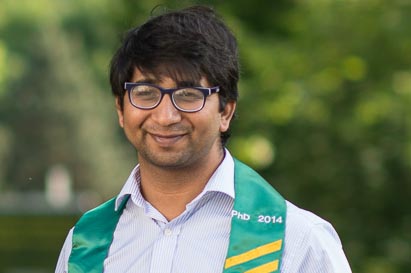
MY RESEARCH AREA RELATES TO USING PROGRAMMING LANGUAGES AND FORMAL METHODS TO HELP PROGRAMMERS AND DESIGNERS DEVELOP RELIABLE, SAFE, AND CORRECT SYSTEMS. IN PARTICULAR, I HAVE BEEN WORKING HEAVILY ON PROGRAM SYNTHESIS. HOWEVER, I’M INTERESTED IN ALL DOMAINS OF FORMAL METHODS AND RIGOUROUS SYSTEM ENGINEERING.
Arjun Radhakrishna joined IST Austria in 2009 as a PhD student in Thomas A. Henzinger’s group. His doctoral thesis on “Quantitative Specifications for Verification and Synthesis” won the ACM SIGBED Paul Caspi Memorial Dissertation Award. Currently, Arjun is a postdoctoral researcher at the University of Pennsylvania. We interviewed Arjun about his experience as a PhD student and about his transition to postdoctoral researcher.
I first became interested in computer science in high school when I learnt about programming. This was about 15 years ago, so the interest has always been there and has stayed with me.
I did my PhD right after my bachelor’s. After my bachelor’s I still felt that there were more things to learn than I already knew. I had the opportunity, so I decided to take it.
That was mainly because of Tom [Henzinger]. I did an internship with him when he was still at EPFL. I really liked the work I did during the internship and asked if I could work with him. He replied that he was moving to IST Austria so I decided to join him there.
It was really nice. We had a very pleasant group of people to work with. Something you come to appreciate is that the group you work with is just as important as the advice you get on your work. Tom is really good—there is no question about that. That is by the way another great thing about IST Austria, that the faculty is really good. We had advice available for whatever project we were working on.
We met about once a week on average. Meeting Tom once a week was really a privilege. Within a few minutes, he could understand exactly what I had been doing the previous week and could give me thoughts and advice that would guide me for the next week. He has this skill that many good researchers have of asking exactly the right questions that makes you think about the problem in the right way.
I also did a lot of work together with postdocs and we had a lot of fruitful collaboration together.
Paint, and I read a lot. Reading was my main hobby. My new year’s resolution every year while I was a PhD student was to read one novel a week. [Laughs] I never quite achieved that, but I read a lot. Two of my favorite authors are Milan Kundera and Terry Pratchett.
As a graduate student you’re mainly working on your research. But at IST Austria you also develop a way of thinking, which is much broader than what you get at a regular computer science or engineering department.
The great thing about being at IST Austria is that you get to meet people from a wide range of subject areas, such as computer science, life sciences, and mathematics. This broadens your mind.
At UPenn, I am at the school of engineering and applied science. I get to meet a lot of people who are doing cool engineering, and I didn’t have that chance before. That’s something different. There are also more students at UPenn than at IST Austria and this also gives me more opportunities to teach.
It’s definitely not smooth sailing. You struggle a bit, you have your ups and downs. But that’s what the PhD is about. You stay with it, and you persevere.
It’s really hard to give advice. Every student is different and every advisor is different. But I would say, perhaps try not to stick to just one problem but work on a few different problems. And as I suggested before, for a PhD student, much more important than any other quality is perseverance.
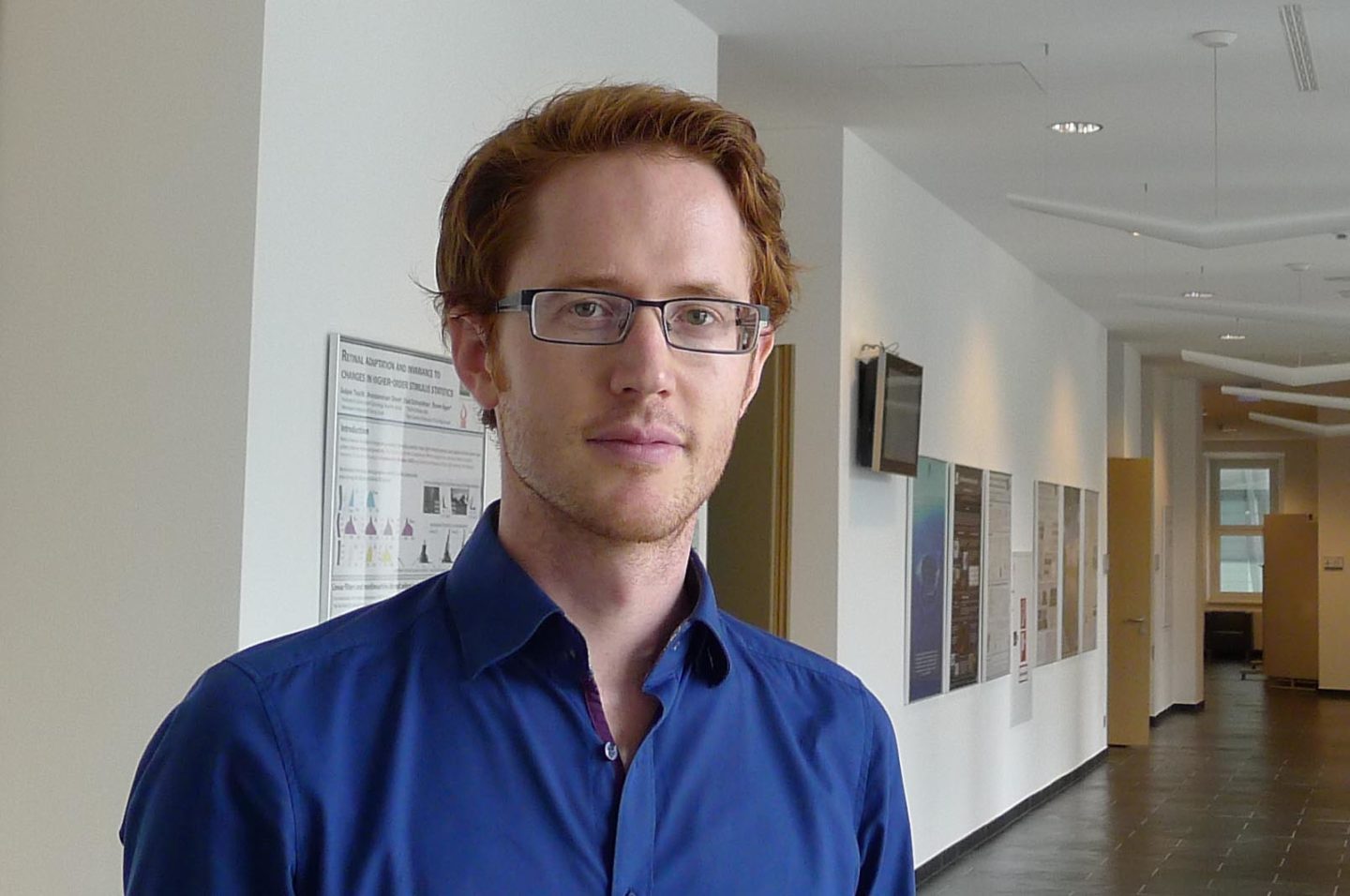
PRECLINICAL DRUG DISCOVERY IN NEUROSCIENCE WITH FOCUS ON ELECTROPHYSIOLOGY, OPTOGENETICS, AND DATA ANALYSIS
Philipp Schönenberger was a postdoc in the Csicsvári group from 2011 to 2015 before moving to his current position in industry. He is now a research scientist at Roche, a multinational healthcare company. He works in preclinical drug discovery in neuroscience with focus on electrophysiology, optogenetics, and data analysis.
During a visit to IST Austria in June 2017, he talked to Daniela Klammer and Kathrin Pauser about what it is like to be a researcher in industry, how he perceives the transition from academia to industry, and how to be successful in the job application process.
Also while on campus, he gave current students helpful tips on how to successfully apply to industry jobs during a special Think&Drink.
This is simple: “scientist”.
The coolest thing about my job is that we provide data that informs decisions about how to move ahead with projects. I like publications, but they can be the end of a story: everybody is happy, and you move on to the next thing. In our case, however, if we have data that is useful, it will be used later by other teams. This is very satisfying.
Somewhere around science, I think. I am a scientist at my heart, and now, I have seen more and more functions around science that are extremely interesting. So, while I don’t think I want to do experiments for the rest of my life, I want to be close to science. I particularly like this place between the preclinical and clinical development phases because it represents a major challenge in drug discovery. It’s a high risk transition, and if I can contribute to bridging that gap, then this is an enormous achievement as well as an interesting challenge.
I have a master’s in cell biology; in particular, I studied viral infections and the transport of viruses. Later, I moved into in vitro neuroscience in order to understand how neurons exchange signals. Then, it was a natural step to ask the same questions, but this time for the “intact” animal—in particular, to understand how neuron communication contributes to the formation of memories. That is essentially why I came to IST and chose to work with Jozsef.
It is here that I learned the concepts behind this kind of research, and gained the expertise necessary to perform it. It was absolutely fun, and also prerequisite for my current function. Plus, scientifically speaking, this kind of research is the most interesting thing you can do. My world view is still influenced by these experiences.
I encourage everybody to go to job fairs. I thought I was always too busy for that, and I don’t like networking. But I would still encourage everyone to do this. Even if you find out that something is not your cup of tea, then at least you know.
I think the difficult thing is the transition from academia to a place you don’t know. Industry was a big unknown—at least it was for me—but I now realize it was the same for most of my colleagues. Talking to people and networking helps a lot. That’s one thing I would definitely encourage.
And then, it’s not a bad idea to build up your CV a bit. Things like mentoring experience don’t hurt, a one- or two-day project management course can be helpful, too. All these things that you hear about, but usually ignore. When a company gets applications, they have a few things they want to see. It is so much easier when they know somebody has been exposed to industry, so they know the applicant knows roughly how it works and is interested. Your CV is what they use to make that first decision.
Internships help, I did one. Back then I was not specifically interested in disease, but during my master’s I did an internship in Cardiff in a group that works on Huntington’s disease. Of course I wrote that in bold letters on my cover letter. Why? Because a company looks for someone with not only the skills, but also the interest. Somebody who understands the questions behind the research. In a cover letter or CV, an internship is like a label: “I tried it, I liked it”. If you have a chance to do an industry internship, it is very valuable: it can be a door opener…and it can also make you certain that you don’t want to go into industry!
One specific event I remember is when—after a year and a half of work—my experiment worked for the first time. That is something I will always remember, first because it was really hard, and second because all these people said: “This can’t work, the physics almost forbids this.” This was a scientific “eureka” moment.
And then, I have many fond memories of sitting at the IST pond with my colleges and taking lots of time to discuss ideas in depth. I don’t have time for this now, and this is what I miss.
The diverse options—in the longer run—that you have in a company. For me, that was the most important factor.
Very simple! There are only a handful of labs in Europe that do this type of research, and Jozsef’s was one of them. He told me from the beginning that he was moving to IST, and I thought living in Vienna must be fantastic…I loved living in Klosterneuburg, it was a pleasure to be able to cycle to work and still be only 20 minutes from the city.
I saw the job and thought it sounded very interesting, and that it would be an excellent opportunity. Then, I contacted someone I know who worked at Roche, to get an idea of what they are looking for in an applicant. Later, they contacted me for a phone interview.
Practice a lot, and even rehearse for a possible video interview. While preparing, check things like the background, and make sure there would be good light, but for instance no window behind you.
Also come up with some questions beforehand. Don’t be passive! It’s good to show interest, and not only that, it is your chance to find out if this is the right job for you.
Research in academia and research in industry are both science on a high level, but in industry, research is far more cooperative. We have to work together: it is not only the group that has to succeed, it is the entire section.
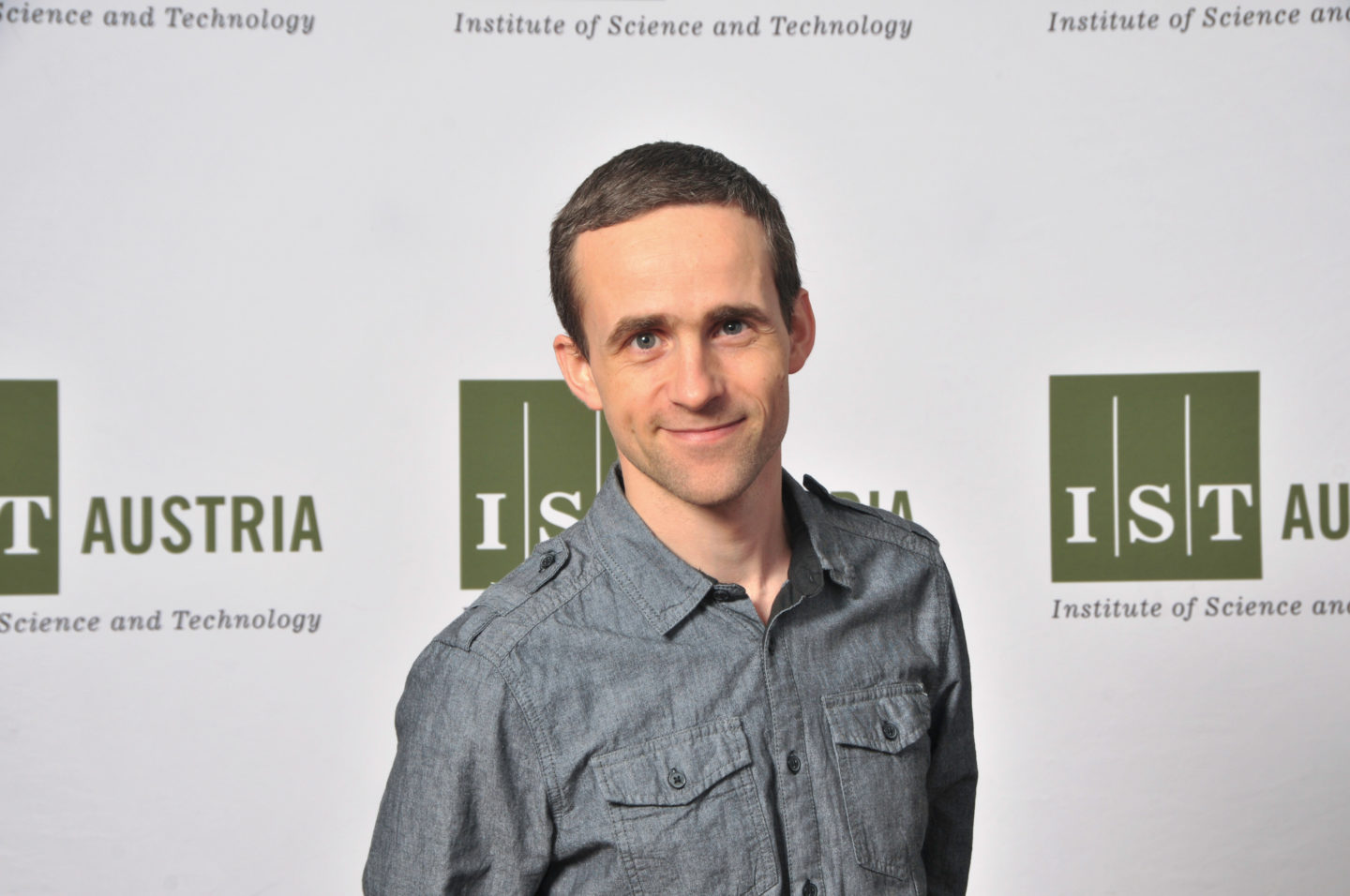
Stefan Jeschke is in the unique position of having left IST Austria and at the same time not having left the campus. He works now for Nvidia. Although the company which designs graphic processing units is based in Santa Clara California, Stefan Jeschke has rented an office on the IST Austria campus and works from there mainly communicating via skype and email with his colleges from all over the world. In an interview with Daniela Klammer and Kathrin Pauser he answered some interesting questions about his work.
Watch a short version of the interview here on youtube or read the long version below!
Stefan Jeschke, researcher at Nvidia.
Basically what I am doing is basic research, like I did at IST, I am working on realtime algorithms for future computer games.
I am very free in what I am doing, as long as it is exciting and interesting for my managers. Whenever I find something that excites me I can work on it as long as I want or until something cool comes out. I am very free at choosing my time to work, where I work and how I work. We have a very international community at nvidia. I am basically working with people from New Zealand, from Bangkok, all around the world and the US of course. It is an interesting environment to work.
No, it is all skype meetings and online.
Hopefully in the same job, if this works out. This is basically my dream job, I would say and I have no intent to change anything soon.
I have a classic academic career bachelor and master computer science, computer graphics in my case. Then I did a PhD in 2005, followed by quite a few postdocs in different universities: TU Vienna, Arizona State university in Phoenix, Arizona, then TU Vienna again and then IST until last year.
I learned a lot of new stuff here. The guy I was working with was Chris Wojtan he does physics simulations and I didn’t do that before too much. So I learned a lot from that perspective. He also introduced me to the job I have now. He made the connection for me so that was a very positive influence. I am still working with him quite a lot. So overall it is a very positive influence.
It was only like twenty steps, literally[laughs]my current office is only twenty meters away from my old office. Also was not such a big step because I still work in the same area I am still doing basic research as I did before. So in my case the difference is not that big but that might be very unique. I also have publications at the same conferences as before. I tend to pressure myself to publicize while my manager is more interested in demos for GTC but of course he also likes publications.
One advice is what worked out for me I didn’t think too much of a career to do but rather what I liked to do which was not too hard because in Austria all the contracts are short term anyways. Doing that what you like most at the moment is probably the best strategy to keep a healthy relationship to your job. Basically I never thought too much about long term because there are no long term perspectives for postdocs or similar positions in Austria. Just keep your focus on what you are doing now and do your best and go from there.
This is a hard question. I enjoyed the photography club we always had nice meetings. That’s one thing. Of course the scientific rewards are another, doing really great work and having great papers accepted at the best conferences – that is certainly something that I remember.
I had been at IST for some of the lectures and I think it was my wife that said, why don’t you apply there. What I liked is that there are only few students but those students are highly motivated and I liked that. That was one of the reasons to choose IST.
I would say it is pretty unique. As far as I know, I am the only employee in Austria at Nvidia and that was quite a struggle to get that but now I can work from where I want within Austria.
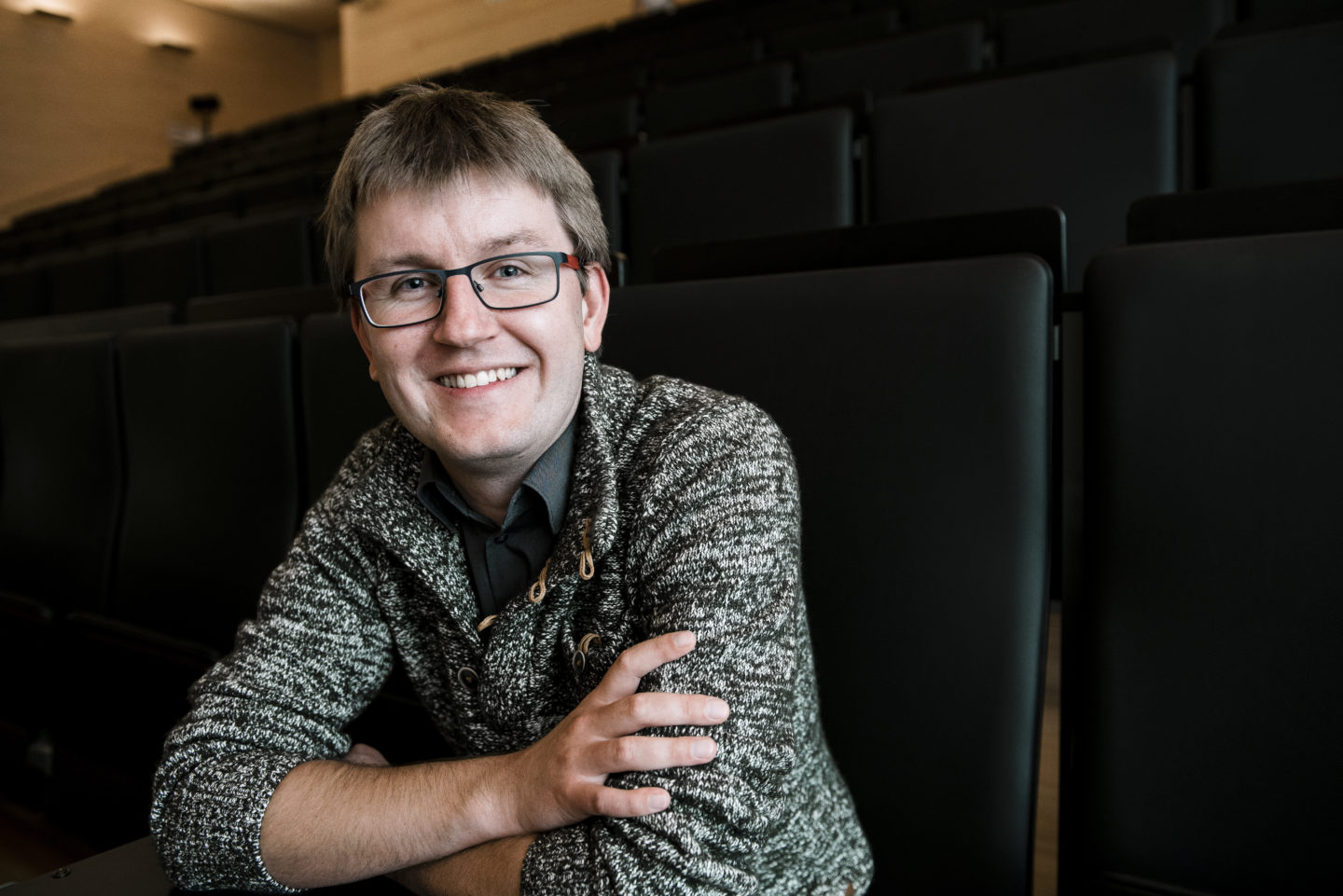
Martin Chmelik was a PhD student at IST Austria. He now works for TTTech. TTTech is the leading supplier of dependable networking solutions based on time-triggered technology and modular safety platforms. At IST Austria Martin Chmelik was in Krish Chatterjee’s group. His thesis with the title “Algorithms for Partially Observable Markov Decision Processes” won the Best Thesis Award at IST Austria 2016.
In an interview with Daniela Klammer and Kathrin Pauser, he answered some interesting questions about his work.
Martin Chmelik, research engineer at TTTech
I am working in a research group at TTTech and in our team we are building the very first versions of products. We are doing research in the area of scheduling, real time control and computation in hypervisors and building those into very early version of products that we then show to our potential customers.
The thing with computer scientists nowadays is that the challenges and opportunities are everywhere. So one doesn’t need to worry too much about the long term future and more on the current state and be happy with the work you are actually doing.
I did my masters at Masaryk University in Brno. I went to an Erasmus in Denmark in university of Aalborg and then I joined IST.
A very important one. There is some truth in the saying that you become the average of the five people you work most with. So in that sense, you should surround yourself with very smart and hard-working people. I think that IST was exactly the right place for me in that sense. So I think it played a very important role in my life.
The first one would be to enjoy your time at IST Austria and use everything that IST is offering. I think it is excellent environment and current students should make use of it.
Second, is to travel to conferences, to join workshops, organize events. Talk to people share ideas get new insights, be known in the community.
The third one is more general to ask questions. Because it seems to me at the moment when you don’t ask a question because you are afraid it is not a smart enough question then it actually accumulates. So from every first moment you should ask questions that are interesting for you.
This should probably be something like defending my PhD thesis or something like that. But actually form me it could be the table soccer tournament that took place annually. I was playing regularly but I never won. This kind of stays in my memory.

Thorsten Tarrach was a PhD student in the Henzinger group at IST Austria, and is currently working as a research engineer at AIT in Vienna
May Chan from Graduate School Office interviewed Thorsten at his workplace at AIT to find out what it was like to leave IST Austria.
I’m a research engineer at AIT (AIT – Austrian Institute of Technology). There are two career paths for scientific/technical staff, which are research engineer, and scientist. For me the research engineer is a perfect position because it combines both the technical aspect of doing the implementation, which I’ve always enjoyed, but it also has a scientific side to it, where I’m involved in the paper writing and will be co-author on some of the papers. I will also be doing theoretical work before we can start implementing things. It’s not like your typical implementation job in industry, where you use existing technologies—here at AIT we’re really working at the forefront of technologies.
My first task has been to work on MoMuT [Model-based Mutation Testing], an existing framework that has been developed mostly at AIT. In the computer industry, a large part of the work is to test programs, which is a very time-intensive and labor-intensive task. We want to automate that—we want to automatically generate those tests for the customers.
Essentially, we are mutating the specifications and the mutated one is wrong. Then we’re trying to find a test case that can distinguish the wrong one from the right one. So a test case is essentially a set of inputs that we use to observe the output the computer gives us. If you had for instance an input “3” and the output given by the computer is the same as the correct one, then you couldn’t see any difference and couldn’t see if the system was behaving incorrectly. But if you gave it the value “0” and the output is not the one we expected, then the value “0” would be a good test case. So, we are trying to find those inputs for which the system shows deviation from the correct execution.
It’s an exciting, new thing that’s being done here, something that you can writes papers on. We’re not just using existing techniques, but developing new techniques here, yet at the same time–which is different from at IST Austria—here we’re really trying to create a product out of that research that’s usable for industry. At IST Austria, we would always stop with a research prototype and a few examples—you would never bring it to the production level.
I worked with Tom Henzinger at IST Austria. He’s the President and also one of the most senior computer science researchers in Europe. It was a great privilege to be able to work with him. Despite all his obligations he actually has quite a lot of time for his students. We had very regular meetings and there were four students in the group, which is really an excellent ratio.
I think it really depends a lot on what’s coming up in the next couple of weeks. I think my experience work-wise is that it was quite cyclic, coming in recurrent waves. The work intensity really goes up before the deadlines, and after that it’s much more relaxing. Generally, what I also felt as a student and as a postdoc, people are really engaged in their work all day round, seven days a week. Whereas here[at AIT]the working days are much more clear-cut. After eight hours you go home and then you can forget about the work.
At IST Austria I was working in a very similar field, so we worked on verification—we were trying to prove that the software is correct. This is a bit different from the testing approach that’s being done here[at AIT]. But it’s also much more restrictive in terms of what size of programs can be handled because the technique we used was computationally more expensive.
We went a little bit further, we didn’t just want to see if the program is correct or not, but we wanted to automatically repair the program. This is called synthesis. Synthesis or automated program repair are somewhat synonymous. This is what I worked on for my thesis. So we would take a computer program—essentially software and source code—and then I developed for my thesis a little tool or a research prototype (it’s not fully usable) and that tool would analyze the program, find certain kinds of defects, and automatically repair the code of the program. It deals with a certain class of programs called concurrent programs.
I was already interested as a child. It started with my father’s Comodore 64, where I would try some simple basic programs. I was probably eight back then. A bit later we got the first actual PC, and my dad brought home a box with Visual Studio 2. Then I started writing small programs, and I remember when I was fifteen, I took part in a local competition where people present different programming work that they did. I wrote a vocabulary trainer. Essentially it had a database where it had German and corresponding foreign language words. It would show you the German one and ask you what it should be in the foreign language—you could type this in, and it would tell you if it’s correct or not.
I wanted to study computer science very early on. I started my bachelor’s at the University of Saarland, Saarbruecken. And during my bachelor’s I went on Erasmus (a European exchange program) to Trinity College in Dublin, Ireland, staying there for 9 months. I also did a 9-month internship at Microsoft in Dublin, doing software development.
I then did my master’s in 2010 and worked for 2 years in a small start-up like environment. After 2 years I was interested in doing a PhD. For personal reasons, I chose Vienna and my former colleagues happened to tell me about the work of Krish Chatterjee. I wrote Krish an email, and a few days later I got an email from the Graduate School Office, saying they would like to see a full application. I was very lucky that I was invited for an interview (there were about 600 applications).
I heard about Krish but once I applied and read through the list of professors, I found Tom’s research interests were much closer than mine. In the end I did rotations with Krzysztof Pietrzak, Christoph Lampert and Tom Henzinger, and it was clear that working with Tom was what I wanted.
At the beginning I was working with Pavol Cerny, formerly postdoc in Tom’s group (now a professor at UC Colorado Boulder), as well as with Arjun Radhakrishna, another PhD student. It was very lucky for me I could work with them. They had a very good idea, and my task was to do the implementation, which is what you typically start with as a PhD student. I worked on that during my rotation, and worked very hard on it—during weekends as well. The paper got accepted at CAV[Computer-Aided Verification], and I got my first CAV paper before I even affiliated. And I could never have done it by myself due to the lack of experience, but this worked out really nicely, and that’s also what enabled me to finish my PhD after 4 years. I essentially continued working with both of them throughout the entire PhD and we produced a succession of 4 papers. We were all lucky that these papers got accepted at first attempt.
I typically went to work rather early, coming in at 8:30 or 9:30 latest. For me the morning was usually the quiet time when you get a lot of work done, I find. I particularly enjoyed the lunch break with others, and we usually went for a coffee right after. I enjoyed this social interaction. In the afternoon, we usually had meetings scheduled and there were talks.
I was mostly Vienna-based. I didn’t make use of the socializing opportunities at IST Austria as much as one could have.
Yes, the environment is very nice. The atmosphere there is also such that you’re encouraged to take breaks, there’s a gym, people go running and so on.
In the first year, we interacted a lot as we shared an office so we were bonding a lot. But when you join different research groups, you get separated a bit more. In the end you hang out mostly with people from your own and related groups. You don’t see students from other subject areas as regularly anymore. But you still bump into them on campus, in the gym, and find out what they are working on.
Think & Drink was also a good way of bringing together people.
I was socializing regularly, mostly with other students at IST Austria.
Some of the best times at IST Austria were the retreats. PhD students organize their own retreats, and the institute has its own retreat. But the student one is really the best. You get to know other students very well through those.
I think AIT is a bit special, in that it is not as strict as an industry job, but I think there are a few common points that you experience in transition to both AIT or industry, which is that you have a much more clear-cut work/life balance, both in terms of time and the tasks that you have to perform, which are usually very clearly laid out. As a PhD student, the first thing is you have to motivate yourself, you have to keep track of your own time, in the sense of making sure you do enough work, or—for some people this is more of a problem—know when you need a break.
I chose this job at AIT because I thought my knowledge from IST Austria was useful. I was lucky in that IST Austria didn’t just prepare me in the abstract sense, such as knowing how to work on your own on your projects—these are things that doing a PhD and being at IST Austria can equip you with; but also with the concrete knowledge from the papers I read from my projects, from the write-up—these are very applicable to my current position.
Tom suggested to me that a PhD is always useful, no matter what job you end up doing—you learn how to acquire new knowledge yourself, by learning how to learn. This skill is transferable to other realms, whether you take up a research or industry position, or join a start-up.
I’m happy at AIT. One benefit of this job is that it’s permanent. One of the reasons why I didn’t pursue an academic career was that you constantly have to move. And it’s unclear, even if you’re very good, if you will get a position. I felt like settling down and having a job where, if I wanted to, I could stay.
First, you have to be prepared to work hard for it. But of course at the same time you need to take care of your work/life balance. You can’t be working hard for four years non-stop. A good start of your PhD—a lot is in the hands of your advisor, but it’s also good to have more senior PhDs or postdocs, to work with you on the project, and to see themselves as having a supporting role for your first paper. It’s good to listen to advice of both your supervisor and the people you’re working on the paper with. They have more experience and can provide guidance on how to, for instance, work on collaborations with other groups. Be humble, work hard, and understand that the hard work will pay off whether it is now or later.
It’s important to not only focus on the work you’re doing at the moment, but to also keep a broader view of your research area, to listen to talks, go to conferences, irrespective of whether it’s directly related to your current project or not.
And while IST Austria basically offers an environment where you don’t have to speak any German, many people consider going to industry after their PhD and staying in Vienna, so learning some German could prove useful. A few PhD students I know have stayed in Vienna and settled with industry positions.